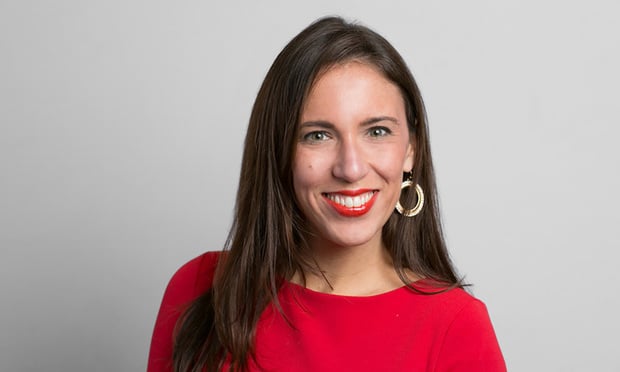From the Editor-in-Chief: The Ties That Bind
Law firm leaders are struggling to balance the demands of a partnership with the more businesslike demands of the current legal model.
May 22, 2018 at 09:31 AM
4 minute read
 Gina Passarella, Editor-in-Chief of The American Lawyer.
Gina Passarella, Editor-in-Chief of The American Lawyer.
I've noticed a common thread in my recent discussions with law firm leaders, and it all relates back to the core founding principle of most law firms: partnership.
 Dive into the Am Law 200 data and personalize it based on your firm, peers and trends. Learn More
Dive into the Am Law 200 data and personalize it based on your firm, peers and trends. Learn MoreConversations about the evolving legal industry inevitably lead to how much firms are able to change, and how quickly. And with that come discussions about balance. How far can firm management really push their partners when, after all, they are partners?
The dictionary has a special definition for partners by law, noting they are people “associated with another or others as a principal or a contributor of capital in a business or a joint venture, usually sharing its risks and profits.” But just how much are they sharing in the decision-making? And when a new model of law requires more businesslike (read: cutthroat) decisions, sharing equally in those risks and rewards becomes almost untenable.
My sense is that many firm leaders, whether it be at the top of the Am Law 100 or the bottom of the Second Hundred, are genuinely struggling with this issue. Some may also be using it as a shield to protect against having to make the difficult changes the industry (and their client base) requires.
I have to admit I would often roll my eyes at the constant refrain of how important culture was at a law firm. All that seemed different in the descriptions, after all, was the firm name. But I've come around to believing there is some truth to how much culture can seep into the business functions of a firm. Many firms attest to leaving profits at the door as a result of decisions based on culture and commitment to partnership (though PPP growth may not back that up).
 Dive into the Am Law 200 data and personalize it based on your firm, peers and trends. Learn More
Dive into the Am Law 200 data and personalize it based on your firm, peers and trends. Learn MoreAll this is to say that I wonder how much partnership values and culture are protecting firms and how much they are hindering efforts to adapt. This issue of The American Lawyer is flush with examples of how firms are trying: trying to differentiate themselves and grow among their Am Law 200 competitors; trying to improve diversity within their walls; trying to manage their offerings and staffing to economic realities, real and prospective; and trying to decide whether to merge or grow organically.
Would those efforts be easier if the partnership model wasn't in the way? Or are the firms that are holding onto partner values doing themselves a favor by protecting against things like one anecdote I recently heard about a firm whose partners all took a pay cut to bring on a lateral at a guaranteed price. (That story makes all-partner votes on what brand of coffee to buy sound attractive.)
There are no easy answers to any of this. I think the next generation of lawyers, hailed as the ones who will bridge gaps in technology or work-life balance, could equally help move firms to a more businesslike environment. But will that require also moving away from the LLP to some other model? A bigger acceptance by the general partnership that not all partners are created equal? Or a greater willingness by firm leaders to do what's best for the organization rather than the individual partner?
There are no simple solutions, and balance is often the best approach. In the end, maybe it's culture that will truly end up differentiating firms after all.
This content has been archived. It is available through our partners, LexisNexis® and Bloomberg Law.
To view this content, please continue to their sites.
Not a Lexis Subscriber?
Subscribe Now
Not a Bloomberg Law Subscriber?
Subscribe Now
NOT FOR REPRINT
© 2025 ALM Global, LLC, All Rights Reserved. Request academic re-use from www.copyright.com. All other uses, submit a request to [email protected]. For more information visit Asset & Logo Licensing.
You Might Like
View All
From the (Departing) Editor-in-Chief: Thank You From The Bottom of My Heart
5 minute read
Despite the Effort, Structural Blockers, Not Ennui, Stall Law Firm Diversity Efforts
4 minute read
Trending Stories
- 1With New Civil Jury Selection Rule, Litigants Should Carefully Weigh Waiver Risks
- 2Young Lawyers Become Old(er) Lawyers
- 3Caught In the In Between: A Legal Roadmap for the Sandwich Generation
- 4Top 10 Developments, Lessons, and Reminders of 2024
- 5Gift and Estate Tax Opportunities and Potential Traps in 2025 for Our New York High Net Worth Clients
Who Got The Work
J. Brugh Lower of Gibbons has entered an appearance for industrial equipment supplier Devco Corporation in a pending trademark infringement lawsuit. The suit, accusing the defendant of selling knock-off Graco products, was filed Dec. 18 in New Jersey District Court by Rivkin Radler on behalf of Graco Inc. and Graco Minnesota. The case, assigned to U.S. District Judge Zahid N. Quraishi, is 3:24-cv-11294, Graco Inc. et al v. Devco Corporation.
Who Got The Work
Rebecca Maller-Stein and Kent A. Yalowitz of Arnold & Porter Kaye Scholer have entered their appearances for Hanaco Venture Capital and its executives, Lior Prosor and David Frankel, in a pending securities lawsuit. The action, filed on Dec. 24 in New York Southern District Court by Zell, Aron & Co. on behalf of Goldeneye Advisors, accuses the defendants of negligently and fraudulently managing the plaintiff's $1 million investment. The case, assigned to U.S. District Judge Vernon S. Broderick, is 1:24-cv-09918, Goldeneye Advisors, LLC v. Hanaco Venture Capital, Ltd. et al.
Who Got The Work
Attorneys from A&O Shearman has stepped in as defense counsel for Toronto-Dominion Bank and other defendants in a pending securities class action. The suit, filed Dec. 11 in New York Southern District Court by Bleichmar Fonti & Auld, accuses the defendants of concealing the bank's 'pervasive' deficiencies in regards to its compliance with the Bank Secrecy Act and the quality of its anti-money laundering controls. The case, assigned to U.S. District Judge Arun Subramanian, is 1:24-cv-09445, Gonzalez v. The Toronto-Dominion Bank et al.
Who Got The Work
Crown Castle International, a Pennsylvania company providing shared communications infrastructure, has turned to Luke D. Wolf of Gordon Rees Scully Mansukhani to fend off a pending breach-of-contract lawsuit. The court action, filed Nov. 25 in Michigan Eastern District Court by Hooper Hathaway PC on behalf of The Town Residences LLC, accuses Crown Castle of failing to transfer approximately $30,000 in utility payments from T-Mobile in breach of a roof-top lease and assignment agreement. The case, assigned to U.S. District Judge Susan K. Declercq, is 2:24-cv-13131, The Town Residences LLC v. T-Mobile US, Inc. et al.
Who Got The Work
Wilfred P. Coronato and Daniel M. Schwartz of McCarter & English have stepped in as defense counsel to Electrolux Home Products Inc. in a pending product liability lawsuit. The court action, filed Nov. 26 in New York Eastern District Court by Poulos Lopiccolo PC and Nagel Rice LLP on behalf of David Stern, alleges that the defendant's refrigerators’ drawers and shelving repeatedly break and fall apart within months after purchase. The case, assigned to U.S. District Judge Joan M. Azrack, is 2:24-cv-08204, Stern v. Electrolux Home Products, Inc.
Featured Firms
Law Offices of Gary Martin Hays & Associates, P.C.
(470) 294-1674
Law Offices of Mark E. Salomone
(857) 444-6468
Smith & Hassler
(713) 739-1250










